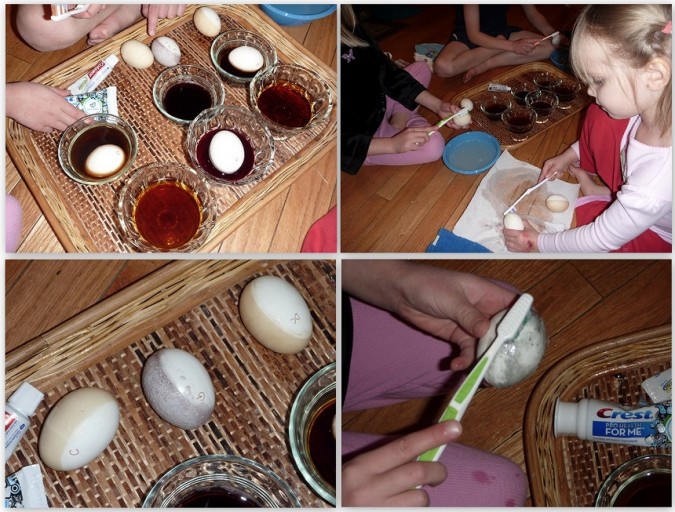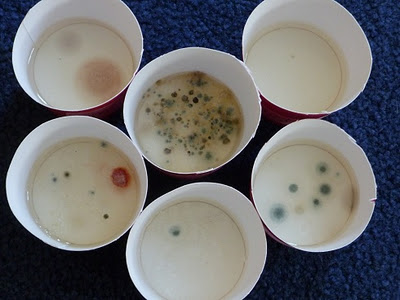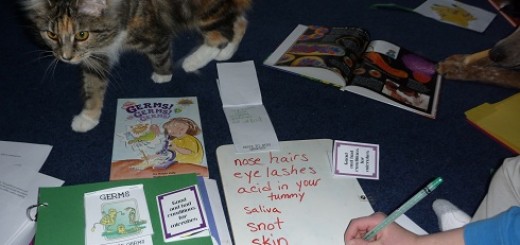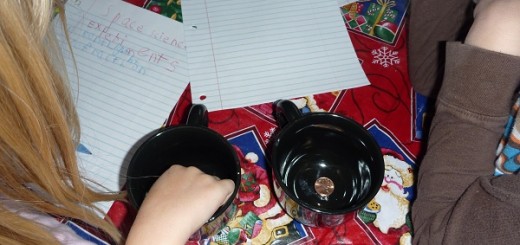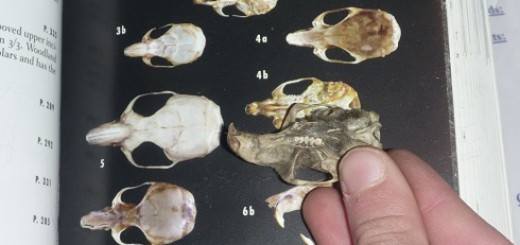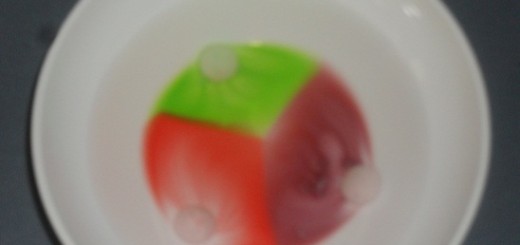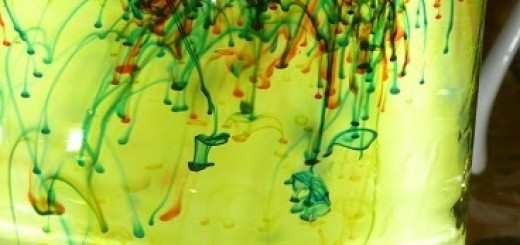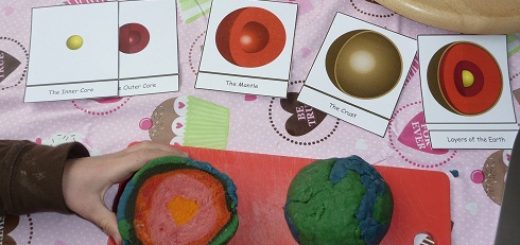Category: Science Experiments
A couple of weeks ago I saw some cute preschool activities about dental health at 2 Teaching Mommies, I was inspired! We didn’t get to Amber’s ideas, but we did fit in the science activities from 1st grade with Miss Snowden. After talking about the germs in our house (see this post), it seemed fitting to talk about the germs in our mouths. I hard-boiled six white eggs and we...
Germ Experiment: When I saw this germ experiment, I knew we had to add this into our unit on First Aid. After all keeping ourselves healthy is as important as patching up the injuries, right?! The experiment called for gelatin, sugar and petri dishes. We didn’t have petri dishes so used paper cups and covered them immediately with glad wrap in lieu of a cover. Boil 1/2 cup of water...
Our germ unit took about a week to complete in part because of the amazing germ-experiment we did (more about that next week… the experiment was awesome!). We talked about the major types of germs: bacteria, viruses, fungi and protozoa. While fungi can produce athlete’s foot and protozoa can cause giardia and malaria, we didn’t go into much detail about those. Some sources also consider helminths (worms) a germ as...
The kids have been begging for some hands-on science experiments. I have a bigger unit planned, but since December and January will be a bit broken up as far as our schooling goes, I decided to delve into a short unit with lots of experiments based on one of Janice VanCleave’s books (202 Oozing, Bubbling, Dripping, Bouncing, Experiments) and lots of notebook/lapbook pages from Homeschool Bits. Here’s some of what...
As I mentioned yesterday, we did a lot of reading about owls to lead into the awesome science study on owls! We talked about the forest food chain (who eats whom) and then I asked them what owls ate. Owls eat mice, voles, snakes and other small animals. They swallow their prey whole and about eight hours later spit out the parts they can’t digest in a pellet of fur...
We had such a great homeschooling day on Monday. I was skeptical we’d get into the groove since we had just had my niece and nephew with us for four days. I brought in some spooky schooling, though and we had a terrific day! I went out and bought some dry ice and we did a number of experiments. You can see suggestions from Steve Spangler science and a couple...
Plants, plants, plants!! That’s still the main focus of our homeschooling life. The kids are enthralled by the growing process this year. The kids tenderly attend to their plots in the garden. We watch each strawberry ripen eagerly. They rush to inspect the blueberries and peas forming! They help bring in the lettuce for our supper each evening.And, they/we are loving the Junior Master Gardener handbook — and are enjoying...
Here are the other two experiments LD and the girls did. It sure was nice just stepping back to watch the kids do this themselves this time round. Color Changing Milk 1) Pour milk onto a plate 2) Add three drops of food coloring (red, blue, yellow) 3) Place a Q-tip in dishsoap. Then carefully place the Q-tip in the center of the plate without moving it around. The colors...
LD was itching to do some of his old science experiments this morning. We had all of the directions collected on a 3X5 ring (from when we did them a year+ ago). LD leafed through and chose several experiments. Here is the first one he and the girls did. It’s been over a year since we last did this experiment, but it still had a real “wow” factor for all...
Just adding this in on Tuesday: I found out today that I have Pneumonia which is why I’ve been feeling ever so lousy. I first saw this activity last year at The Learning Ark. It fit in perfectly with our Earth Science unit. There is also a similar activity using a hard-boiled egg in the book we are using for this unit, How the Earth Works by Michelle O’Brien-Palmer. One...
Some time back, I shared our Indian corn activity. It’s now growing quite tall in big pots at the end of our dining room table! So here’s the corn after about 1 week of being watered. After a while we decided to plant the corn in some empty flower pots. The corn grew steadily. And now it’s about 12-15 inches high! Unfortunately, the corn cob attracted lots of fruit flies. ...
To make our bird unit especially appealing to LD we, of course, had to add in some science egg-speriments! While DD and I were unable to smash our eggs… LD did!! We’re not quite sure why, but then when he tried it with a second egg he couldn’t break it no matter how hard he tried. Anyway, this experiment was designed to show how strong egg shells are and how...
We looked at the air bubbles coming out of this egg when it was placed in vinegar and talked about why the shell is porous. This lets the growing embryo get oxygen. We then talked about how since it is porous it can let things through — like acid (vinegar), acid rain and pollutants. We talked about DDT (how eagles nearly became extinct)– and how poisons, pesticides and so forth...
I just learned about a science website called The Lab of Mr. Q. Wow! What a find! This 8th grade science teacher created a science curriculum for the young elementary ages. He offers the Life Science student and parent texts for FREE! His Life Science curriculum includes these units: 1) Basic Needs 2) Biomes 3) Life Cycles 4) Classification 5) Food Webs 6) Senses 7) Body Organs 8) Cells 9)...
